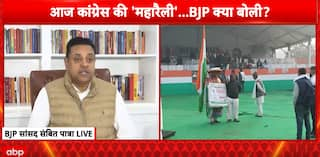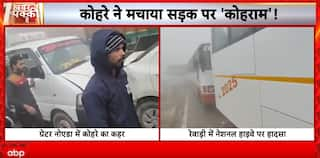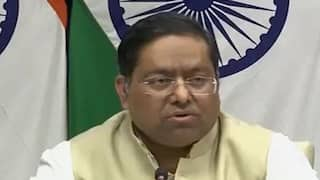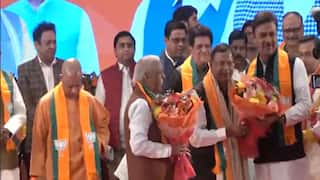Explorer
The Kartarpur Corridor: Sikhism and the Power of In-Betweenness
"It is sign of the pettiness of the governments of both India and Pakistan, and their sheer incapacity to understand the extraordinary and distinct significance of the Sikh faith, that both countries are now squabbling about who first initiated the idea of the Kartarpur Corridor and should thus be able to claim political mileage"

PTI image
The proposed establishment of a corridor that would link Dera Babak Nanak, an important Sikh pilgrimage site on the Indian side which nearly straddles the border, to Kartarpur Sahib, which is about 3 kilometres into Pakistan from the border and one of the principal sites associated with Sikhism, is not merely a step in the right direction. The critical significance of such a gesture cannot be overestimated, but the reasons for this are more complex than is commonly imagined. It has always been a struggle for the two countries to find openings for dialogues, and the Kartarpur Corridor, if it comes to fruition, would likely be one of the greatest measures taken to bring some semblance of peace and civility in the relations between two nations. In this respect, the Kartarpur Corridor may seem to take its place alongside Indo-Pak Bus Diplomacy, the Samjhauta Express, and various so-called “confidence-building” measures.
To gauge the vital importance of this proposed measure, it is best to begin with a brief narrative of the place of Kartarpur in Guru Nanak’s life and the onerous burdens that, centuries later, partition placed particularly on the Sikhs in the Punjab. The extensive travels of Nanak, an itinerant preacher, over a period of nearly three decades ceased when he settled down at a spot on the Ravi above Lahore. Here, as elsewhere, so the tradition says, Nanak first met with opposition from a wealthy landlord, Karoria, who after some mishaps came to the awareness that Nanak was a divine being. Karoria offered to build a village for Nanak and his disciples and it is at Nanak’s urging that this village became known as Kartarpur, after the word ‘Kartar’ meaning the creator. The township flourished as Nanak acquired an ever greater following and it is here that, eighteen years later, he passed away in September 1539. The Gurdwara Darbar Sahib Kartarpur that stands there presently is said to have been built at the site where Guru Nanak breathed his last.
Whatever the Sikh aspirations for their own homeland, the partition of 1947 was particularly hard on the Sikhs, the vast majority of whom opted to settle in India. Kartarpur is one among many vitally important sites of Sikh religion and history, among them Nankana Sahib, the birthplace of Nanak, the shrine of Guru Arjan Dev in Lahore, and the samadhi of Ranjit Singh, that became largely inaccessible to Indian Sikhs. In 1974, Pakistan and India signed a Protocol on Visits to Religious Shrines to facilitate the granting of visas to pilgrims, but the brute fact remains that the draconian visa regime followed by both countries has made sites such as Kartarpur all but out of bounds for most pilgrims. Though Dera Nanak Sahib is, as I have pointed out, important in Sikh history in its own right, nothing could be more poignant than the fact that pilgrims also arrive there since from its precincts they can see the Gurdwara at Kartarpur, the final resting place of Guru Nanak, and thereby also get a darshan of the great founder of their faith: so close and yet so distant.
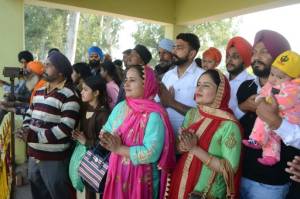 It is sign of the pettiness of the governments of both India and Pakistan, and their sheer incapacity to understand the extraordinary and distinct significance of the Sikh faith, that both countries are now squabbling about who first initiated the idea of the Kartarpur Corridor and should thus be able to claim political mileage. The Modi Government timed the announcement to coincide with the 550th birth anniversary celebrations of Guru Nanak, who was born on 23 November 1469. India, the announcement says, “approached and urged the Pakistan government to recognise the sentiments of Sikh community and build a corridor with suitable facilities in their territory to facilitate easy and smooth visits of pilgrims from India”, but Pakistan’s Information & Broadcasting Minister Chaudhry Fawad Hussain tweeted that “this proposal was initiated by Pakistan.” Indeed, Mr. Hussain has argued that the Pakistan Army Chief “spoke about the opening of the Kartarpur border for the first time. It’s a matter of record.”
It is sign of the pettiness of the governments of both India and Pakistan, and their sheer incapacity to understand the extraordinary and distinct significance of the Sikh faith, that both countries are now squabbling about who first initiated the idea of the Kartarpur Corridor and should thus be able to claim political mileage. The Modi Government timed the announcement to coincide with the 550th birth anniversary celebrations of Guru Nanak, who was born on 23 November 1469. India, the announcement says, “approached and urged the Pakistan government to recognise the sentiments of Sikh community and build a corridor with suitable facilities in their territory to facilitate easy and smooth visits of pilgrims from India”, but Pakistan’s Information & Broadcasting Minister Chaudhry Fawad Hussain tweeted that “this proposal was initiated by Pakistan.” Indeed, Mr. Hussain has argued that the Pakistan Army Chief “spoke about the opening of the Kartarpur border for the first time. It’s a matter of record.”
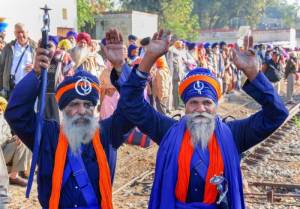 Though it is predictable that each government should attempt to lay claim to this initiative, by far its greater import is that Sikhism occupies a space of in-betweenness with respect to Hinduism and Islam. At his death, Hindus and Muslims quarreled over the performance of the last rites, thus furnishing testimony that they had barely understood his teachings. They may have acknowledged him as a saint—“To the Hindu a Guru, to the Mussulman a Pir”—but to the end they insisted on viewing him from the perspective of their faith. Thus the Hindus sought a cremation for Nanak, while the Muslims a burial: when they tugged at the sheet that covered his body, they found a heap of flowers. The Guru Granth Sahib, for those who recognize the holy book of Sikhism, draws upon elements from both Islam and the worldview of Hinduism.
For students of “religion”, one of the perennially interesting questions is to ponder over what is common and what is distinct in each faith. The distinctiveness of Sikhism resides in its quality of in-betweenness, in the particular manner in which Sikhs straddle several worlds both in the material and spiritual domains. As a people, Sikhs have been energetic, generous, and marvelously receptive and adaptive to new cultures. Any political initiative that holds out the promise of improving relations between Pakistan and India, and strengthening the ties between the peoples of the two countries, is to be welcomed. But in all such measures, Sikhs have a special role to play, if only they—and the governments of the two countries—would recognize that. One hopes that the Kartarpur Corridor, if at all it should become a reality, will push the Sikhs to play a greater role in mediating peace between India and Pakistan.
(Vinay Lal is a writer, blogger, cultural critic, and Professor of History at UCLA.)
Disclaimer: The opinions, beliefs and views expressed by the various authors and forum participants on this website are personal and do not reflect the opinions, beliefs and views of ABP News Network Pvt Ltd.
Though it is predictable that each government should attempt to lay claim to this initiative, by far its greater import is that Sikhism occupies a space of in-betweenness with respect to Hinduism and Islam. At his death, Hindus and Muslims quarreled over the performance of the last rites, thus furnishing testimony that they had barely understood his teachings. They may have acknowledged him as a saint—“To the Hindu a Guru, to the Mussulman a Pir”—but to the end they insisted on viewing him from the perspective of their faith. Thus the Hindus sought a cremation for Nanak, while the Muslims a burial: when they tugged at the sheet that covered his body, they found a heap of flowers. The Guru Granth Sahib, for those who recognize the holy book of Sikhism, draws upon elements from both Islam and the worldview of Hinduism.
For students of “religion”, one of the perennially interesting questions is to ponder over what is common and what is distinct in each faith. The distinctiveness of Sikhism resides in its quality of in-betweenness, in the particular manner in which Sikhs straddle several worlds both in the material and spiritual domains. As a people, Sikhs have been energetic, generous, and marvelously receptive and adaptive to new cultures. Any political initiative that holds out the promise of improving relations between Pakistan and India, and strengthening the ties between the peoples of the two countries, is to be welcomed. But in all such measures, Sikhs have a special role to play, if only they—and the governments of the two countries—would recognize that. One hopes that the Kartarpur Corridor, if at all it should become a reality, will push the Sikhs to play a greater role in mediating peace between India and Pakistan.
(Vinay Lal is a writer, blogger, cultural critic, and Professor of History at UCLA.)
Disclaimer: The opinions, beliefs and views expressed by the various authors and forum participants on this website are personal and do not reflect the opinions, beliefs and views of ABP News Network Pvt Ltd.
 It is sign of the pettiness of the governments of both India and Pakistan, and their sheer incapacity to understand the extraordinary and distinct significance of the Sikh faith, that both countries are now squabbling about who first initiated the idea of the Kartarpur Corridor and should thus be able to claim political mileage. The Modi Government timed the announcement to coincide with the 550th birth anniversary celebrations of Guru Nanak, who was born on 23 November 1469. India, the announcement says, “approached and urged the Pakistan government to recognise the sentiments of Sikh community and build a corridor with suitable facilities in their territory to facilitate easy and smooth visits of pilgrims from India”, but Pakistan’s Information & Broadcasting Minister Chaudhry Fawad Hussain tweeted that “this proposal was initiated by Pakistan.” Indeed, Mr. Hussain has argued that the Pakistan Army Chief “spoke about the opening of the Kartarpur border for the first time. It’s a matter of record.”
It is sign of the pettiness of the governments of both India and Pakistan, and their sheer incapacity to understand the extraordinary and distinct significance of the Sikh faith, that both countries are now squabbling about who first initiated the idea of the Kartarpur Corridor and should thus be able to claim political mileage. The Modi Government timed the announcement to coincide with the 550th birth anniversary celebrations of Guru Nanak, who was born on 23 November 1469. India, the announcement says, “approached and urged the Pakistan government to recognise the sentiments of Sikh community and build a corridor with suitable facilities in their territory to facilitate easy and smooth visits of pilgrims from India”, but Pakistan’s Information & Broadcasting Minister Chaudhry Fawad Hussain tweeted that “this proposal was initiated by Pakistan.” Indeed, Mr. Hussain has argued that the Pakistan Army Chief “spoke about the opening of the Kartarpur border for the first time. It’s a matter of record.”
 Though it is predictable that each government should attempt to lay claim to this initiative, by far its greater import is that Sikhism occupies a space of in-betweenness with respect to Hinduism and Islam. At his death, Hindus and Muslims quarreled over the performance of the last rites, thus furnishing testimony that they had barely understood his teachings. They may have acknowledged him as a saint—“To the Hindu a Guru, to the Mussulman a Pir”—but to the end they insisted on viewing him from the perspective of their faith. Thus the Hindus sought a cremation for Nanak, while the Muslims a burial: when they tugged at the sheet that covered his body, they found a heap of flowers. The Guru Granth Sahib, for those who recognize the holy book of Sikhism, draws upon elements from both Islam and the worldview of Hinduism.
For students of “religion”, one of the perennially interesting questions is to ponder over what is common and what is distinct in each faith. The distinctiveness of Sikhism resides in its quality of in-betweenness, in the particular manner in which Sikhs straddle several worlds both in the material and spiritual domains. As a people, Sikhs have been energetic, generous, and marvelously receptive and adaptive to new cultures. Any political initiative that holds out the promise of improving relations between Pakistan and India, and strengthening the ties between the peoples of the two countries, is to be welcomed. But in all such measures, Sikhs have a special role to play, if only they—and the governments of the two countries—would recognize that. One hopes that the Kartarpur Corridor, if at all it should become a reality, will push the Sikhs to play a greater role in mediating peace between India and Pakistan.
(Vinay Lal is a writer, blogger, cultural critic, and Professor of History at UCLA.)
Disclaimer: The opinions, beliefs and views expressed by the various authors and forum participants on this website are personal and do not reflect the opinions, beliefs and views of ABP News Network Pvt Ltd.
Though it is predictable that each government should attempt to lay claim to this initiative, by far its greater import is that Sikhism occupies a space of in-betweenness with respect to Hinduism and Islam. At his death, Hindus and Muslims quarreled over the performance of the last rites, thus furnishing testimony that they had barely understood his teachings. They may have acknowledged him as a saint—“To the Hindu a Guru, to the Mussulman a Pir”—but to the end they insisted on viewing him from the perspective of their faith. Thus the Hindus sought a cremation for Nanak, while the Muslims a burial: when they tugged at the sheet that covered his body, they found a heap of flowers. The Guru Granth Sahib, for those who recognize the holy book of Sikhism, draws upon elements from both Islam and the worldview of Hinduism.
For students of “religion”, one of the perennially interesting questions is to ponder over what is common and what is distinct in each faith. The distinctiveness of Sikhism resides in its quality of in-betweenness, in the particular manner in which Sikhs straddle several worlds both in the material and spiritual domains. As a people, Sikhs have been energetic, generous, and marvelously receptive and adaptive to new cultures. Any political initiative that holds out the promise of improving relations between Pakistan and India, and strengthening the ties between the peoples of the two countries, is to be welcomed. But in all such measures, Sikhs have a special role to play, if only they—and the governments of the two countries—would recognize that. One hopes that the Kartarpur Corridor, if at all it should become a reality, will push the Sikhs to play a greater role in mediating peace between India and Pakistan.
(Vinay Lal is a writer, blogger, cultural critic, and Professor of History at UCLA.)
Disclaimer: The opinions, beliefs and views expressed by the various authors and forum participants on this website are personal and do not reflect the opinions, beliefs and views of ABP News Network Pvt Ltd.
Follow Blog News on ABP Live for more latest stories and trending topics. Watch breaking news and top headlines online on ABP News LIVE TV
View More








